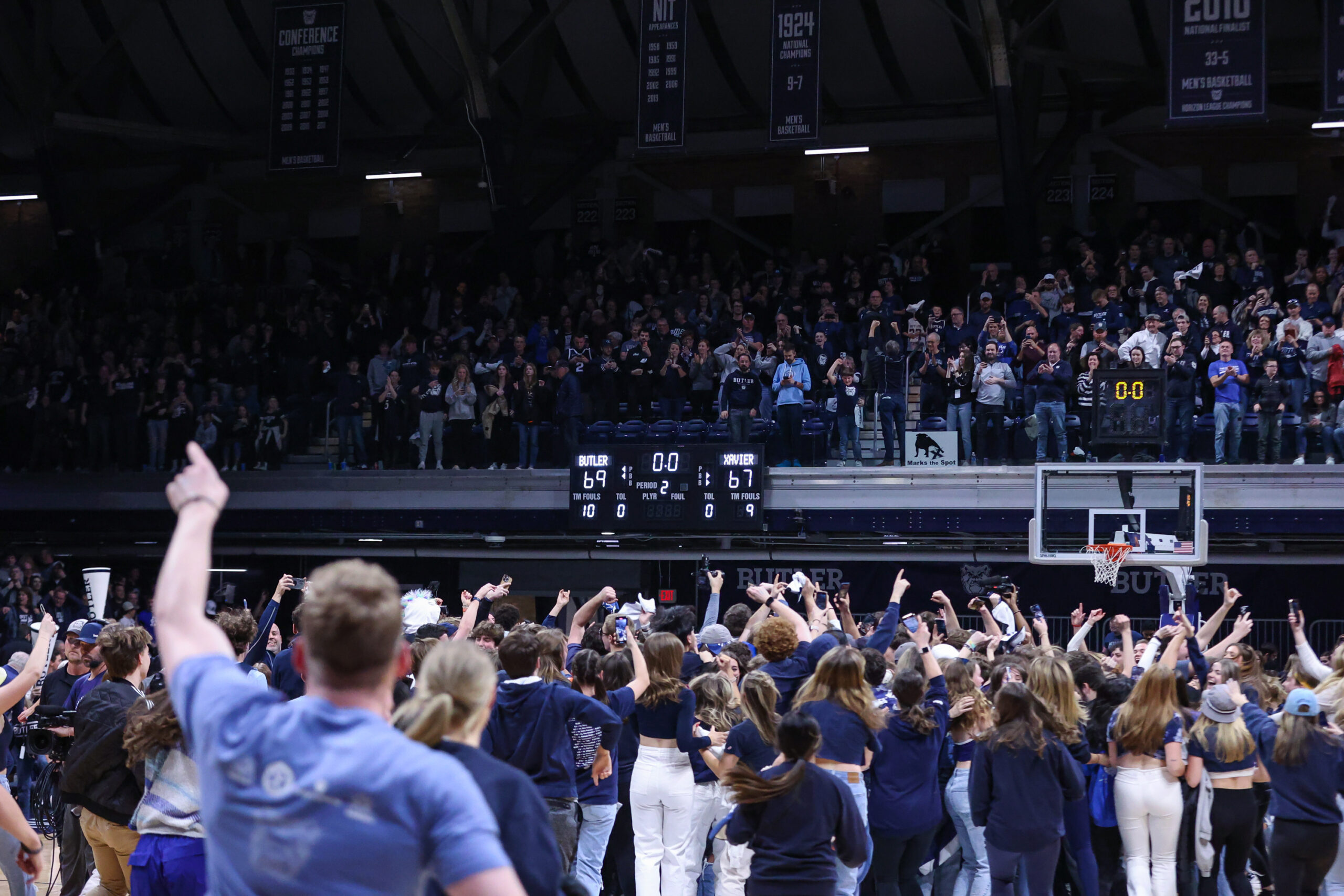Butler students storm onto the court after knocking off 13th-ranked Xavier 69-67 at home. Photo by Claire Runkel.
ETHAN BAKER | STAFF REPORTER | etbaker@butler.edu
Overtime, or “OT,” is an opinion column series where the Collegian takes national sports headlines or polarizing topics and gives them a Butler-centric angle.
When you think about the most famous endings to sporting events, some of them have been followed by the exhilarating act of storming the court. However, storming the court is not as harmless as it might seem. Within the last two months, Duke center Kyle Filipowski and Iowa star Caitlin Clark have been injured as a result of fans running onto the court. These incidents shed light on the potential dangers of fans rushing onto the floor.
While court storming is not unique to college sports, some of the most famous examples come from the collegiate level. Sophomore marketing major Jack Wohlfeil understands how special storming the court can be.
“Court storming is a good thing,” Wohlfeil said. “It’s one of the things that is uniquely college basketball and without it, a part of the charm of the sport would be gone. One of my best sports memories is when I stormed the court versus Xavier last year.”
Hinkle Fieldhouse is no stranger to a storm or two. In 2013 Butler fans poured onto the court after beating No. 8 Gonzaga. In 2017 Butler fans stormed the court after knocking off No. 1 Villanova, and most recently in 2023 Butler fans rushed the court after beating No. 13 Xavier.
Senior men’s basketball player John-Michael Mulloy experienced the game against Xavier first-hand.
“Obviously if you are on the winning side it is a lot of fun and if you are on the losing side it is not a lot of fun,” Mulloy said. “I would just say the biggest thing is security from a player safety standpoint. While there are already security guards out there they know it is probably going to happen [so security needs to be] better prepared for that aspect of it, like maybe allowing the visiting team to make sure they either get off the court or into the handshake line away from where everyone is running.”
One aspect that makes storming the court more suitable to the college environment is the presence of a student section. Student sections, especially those that are close to the court, make it an easier feat to storm like the Dawg Pound located behind each basket in Hinkle Fieldhouse.
So, should student sections be moved higher up to deter crowds of people from storming the court? Not exactly. Having students so close to the game creates a home advantage that cannot be replicated at the professional level. These seats should be used by students because they are the ones that show up an hour early, stay until the end of the game and bring energy throughout.
Wake Forest wasn’t expecting or ready at all for their students to storm the court on Feb. 24 after their win against Duke and it led to injury. Students were on the court before the clock hit zero, and it was a complete failure in terms of keeping the coaches and players safe.
What more can be done? In order to help eliminate the dangerous aspect of court storming, schools need to be more prepared. Having more security on hand toward the end of games when a possible storm situation is foreseeable is crucial to help give players and coaches time to get off the court.
The Big East recognizes the problem. Since 2017 the Big East has had fines in place for court storming offenses. It is a $5,000 fine for the first offense and a $25,000 fine for any repeat offenses. This money gets donated to the charity of the offending team’s choice, for Butler this is Be The Match. Butler received a $5,000 fine for both their offenses in the games against Villanova and Xavier.
In Hinkle Fieldhouse for instance, if it is a close game with less than five minutes to go, more security would be brought down in front of the Dawg Pound. This additional security could help prevent students from running onto the court. They could also bring police and other law enforcement by the visiting bench to help them get off the court.
Senior strategic communication major Kyle McClintock, an avid Butler Basketball fan, gave his input on the necessity of preparation.
“It should be allowed as long as the opposing bench is protected, lots of teams already do it this way,” McClintock said.
Additionally, more pressure from conferences to help incentivize schools to follow these procedures would be helpful. Realistically this would come in the form of stricter fines. For instance, you could increase the fine to $10,000 for a first offense to make it worthwhile for a school to have extra security on hand. The Big East is already on the low end of fines, so this change would bring them closer to the standard of 10 to 25 thousand dollars that the SEC, Big Ten and Pac 12 all implement for first-time offenses.
Ultimately, it comes down to schools being prepared.
As long as schools are ready for the possibility of a court storm then there is absolutely no reason why the historic tradition of storming the court after a big win can not continue.



